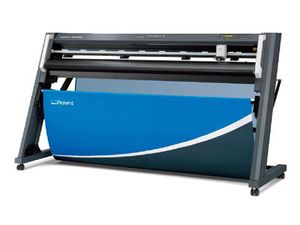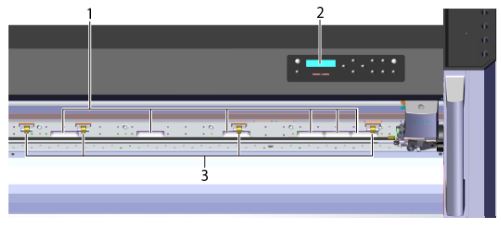Difference between revisions of "Vinyl Cutter"
| Line 175: | Line 175: | ||
## Wipe down machine with a wet cloth | ## Wipe down machine with a wet cloth | ||
Changing Blade: | Changing Blade: | ||
| − | * | + | *[https://files.rolanddga.com/files/gr_use_en/GR_USE_EN_00_basic_top.html Procedure in manual] |
Revision as of 12:22, 30 May 2019
Model: Roland GR-640 CAMM 1
Serial:
Ace: Summer Martindale (Makerhub@georgefox.edu).
Location: The Hub
Description
Vinyl cutting is the process of cutting graphics out of vinyl to make adhesive vinyl applications. The maker hub has a Roland GR-640 cutter. It cuts larger format vinyl than the BN-20 Vinyl Printer, but does not have printing capability. It is used to make stickers/cutouts for applications such as signage, vehicle graphics, apparel, etc. The vinyl cutter is used primarily at George Fox for cutting vinyl sheeting, but can cut other materials if needed for a specific project, see this application page
Documentation
The User's Manual covers many basic things about the GR-640. It has instruction on cutting, maintenance, and calibration. Select the Basic Edition for easy access to these topics.
Terminology:
- Weeding: the process of removing unwanted material from the cut sticker
- Graphic: the chosen image/picture to be formatted and cut
- Adobe illustrator 2017: used to prep the graphic for cutting
- Roland Cut Studio: used to finalize the format of the graphic and send it to the vinyl cutter for cutting
Training
Sticker making is the most frequent use of the vinyl cutter. Uploaded graphics can be in any format, but .pdf is preferred. This is due to the vector format of .pdf files, and lets them be uploaded directly to Roland Cut Studio. Other formats need to be converted to vector form in Adobe illustrator 2017. The vinyl cutter needs to be loaded and setup before a graphic can be sent to it and cut out. Once cutting has been completed, it also needs to be reset and turned off.
Demonstration:
The student will choose a 2 in. x 2 in. graphic and upload into Ai. They will then need to properly format it and send it to RCS. Using RCS, they will finalize and cut the graphic. To finish they will weed the sticker and apply it to transfer paper. They can then choose to save the sticker for later or immediately apply it to a medium of their choice. The student is also responsible for setting up the vinyl cutter before it is used and resetting it after they are done.
General Use:
Loading Material:
- Turn on power
- Feed material through back of machine, vacuum should engage
- Align material with the rollers so it is covered at both corners and within the center if needed
- Rollers can only be placed within the shiny silver strips located along the front of the cutter, above the header
- Rollers are adjusted by sliding them using your fingers
- If possible, check to ensure the material lines up evely with both sets of measurement lines on the lower front of the cutter
- If possible, leave an inch or two of excess material hanging down below the cutting head
- Use the arrow pad to select the type of media: roll, piece, etc.
- Press [ENTER]
- Move the cutting head to the left of the stock via the directional keys, then hold [ORIGIN] to set the starting point of the cut
Prepping/Cutting a Graphic:
- Use Adobe illustrator 2017 (Ai)
- The best practice is to start with a new workspace, and size it the dimensions of the piece of material you’re using
- Initialize Roland Cut Studio
- Open Roland Cut Studio separately, then save your file and restart Ai (this only needs to be done if it is your first time using the vinyl cutter)
- If it’s not already there, drag the Roland Cut Studio tab over to the toolbars on the right side of the screen from [Window] > [Extensions] > [Roland Cut Studio]
- Click the Roland Cut Studio tab on the menu on the right of the screen
- For cut setup, select the GR-640
- The [Output to Cut Studio] button is used once the graphic is fully setup and ready to cut
- Setting up the graphic in Ai:
- File is .pdf (the ideal format):
- Use [File] > [Open]
- Hit [Window] > [Layers], this can also be dragged over to the toolbar on the right side of the screen
- Use this to remove all unnecessary cut paths by selecting only the individual cut line and clicking the trashcan icon in the lower right of the screen
- You’ll know you’ve removed an essential path if that part of the image disappears
- Usually the goal of this step is to remove any large borders around the graphic
- Image size can be edited using the size sliders located on the tool bar near the top of the screen, closer to the right
- File is .jpg/png (any non-vector format):
- Use [File] > [Place]
- Click in the top left corner, then drag with the cursor until the graphic is the desired size
- Use [Object] > [Flatten Transparency] to convert the graphic to vector form, use the high resolution preset
- Click [Image Trace] on the tool bar near the top middle of the screen, then click [Expand], which enables cut lines to be edited
- Once this step is done, the graphic’s cut lines should show up in the Roland Cut Studio preview area, and the graphic should turn black
- Hit [Window] > [Layers], this can also be dragged over to the toolbar on the right side of the screen
- Use this to remove all unnecessary cut paths by selecting only the individual cut line and clicking the trashcan icon in the lower right of the screen
- You’ll know you’ve removed an essential path if that part of the image disappears
- Usually the goal of this step is to remove any large borders around the graphic
- Image size can be edited using the size sliders located on the tool bar near the top of the screen, closer to the right
- File is .pdf (the ideal format):
- Setting up the graphic in Roland Cut Studio/Cutting the graphic:
- Under the Roland Cut Studio tab, hit the [Output to Cut Studio] button, this should load the graphic in Roland Cut Studio
- Click [File] > [Cut Setting] > [Change] > [Get From Machine] to size the workspace properly
- Click [Object] > [Group] > [Group] to merge the cut lines into one group
- Click [Object] > [Weeding] > [Add Border], then add a .25 in. border (this value can be changed if needed), this is done to add a tighter outer boundary to the shape than was maybe in place earlier, and to save material
- Use the Size and Shape window on the right of the screen to rotate or rescale the graphic as needed
- The origin of the cut, as set earlier, should be in the bottom left corner of the workspace
- Once you’re ready, click [Cutting] > [OK]
Unloading Material:
- Use the directional keys to unspool a small amount of excess material
- Hold the [SHEET CUT] button to slice the cut material off, the left edge of the material should be held during this process, taking care to stay out of the way during the slicing process
- Press [MENU] until [UNSETUP] is displayed on the screen, then press [UNSETUP]
- Press [ENTER]
- Press [PINCH]
- Remove the material by moving it through the rear of the machine
- Turn off power
Transferring the Graphic:
- Use the weeding kit to remove all unwanted sections of the graphic
- Tweezers are used to pinch and pull up unwanted sections
- The rounded dental tools are used to hold down wanted sections to prevent them being peeled off with unwanted sections
- If necessary, cut the graphic off from any excess material
- Use scissors to cut out a piece of clear transfer paper slightly larger than your cut-out graphic
- Position it sticky side down over your graphic and use a squeegee to apply it the the graphic
- This is done starting in the center of the graphic, and smoothed with the squeegee from the center out
- Once it is applied, flip the layers over and peel the backing of the vinyl material from the transfer paper
- Peel at the greatest angle possible, aim for parallel to the transfer paper
- Try to peel in a direction that flows with the graphic
- Position the peeled graphic over the medium it is to be applied to
- Starting with one end, begin to feed the graphic down onto the surface
- AS THIS IS DONE, use a squeegee to firmly smooth outward in alternating left and right strokes starting from the midline of the graphic to remove air bubbles
- Continue this process until the graphic is completely applied and all air bubbles are removed
- Peel the transfer paper from the material, in the same manner as the backing of the vinyl was peeled off
*Stickers do not have to be immediately applied to a surface. The process can be stopped at step 4.1 of Transferring the Graphic, and applied later in a similar manner. Using the squeegee to apply is also optional but may result in a less polished final product.
Certification
Troubleshooting
- Not cutting all the way through material
- Increase cut pressure
- If pressure has to be increased by 50 to 60 gf, replace the blade
- Material is ripping/curling when cut
- Replace blade
- Cuts not being made cleanly
- Clean the blade holder cap
- If problems persist, replace the blade holder
- Blade might be dull and need to be replaced
- Blade protector is scratched and not cutting cleanly
- Replace blade protector
Maintenance
Most of the maintenance on the vinyl is incurred by use of the machine, instead of periodically.
| Maintenance Procedure | Frequency | Done By |
|---|---|---|
| Cleaning Machine | When parts are visibly dirty and after periods of heavy use | Student |
| Changing Blade | When needed | Ace |
| Changing/cleaning Blade Holder | When needed | Ace |
| Changing Blade Protector | When needed | Ace |
Turn machine off before performing any maintenance.
Cleaning Machine:
- Grit Rollers
- Wipe away any accumulated grime
- Display
- Wipe clean with a dry cloth
- Pinch Rollers
- Remove any build up material with a brush, do not use a metal brush
- General wipedown
- Wipe down machine with a wet cloth
Changing Blade:

